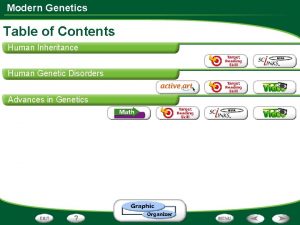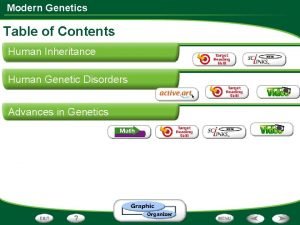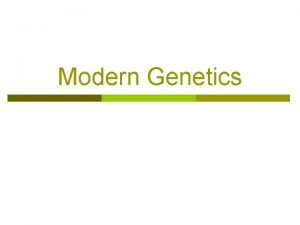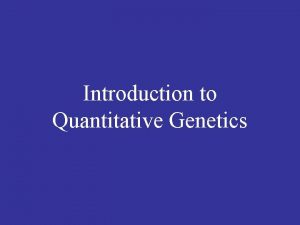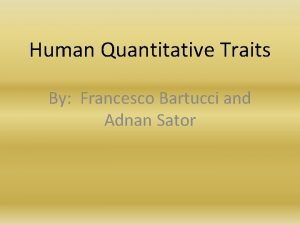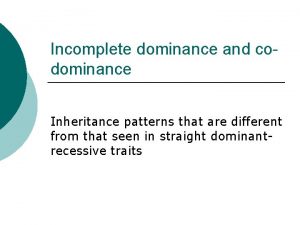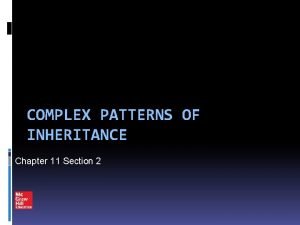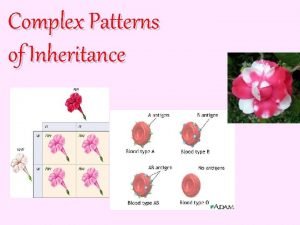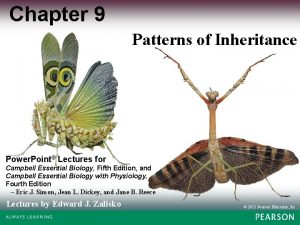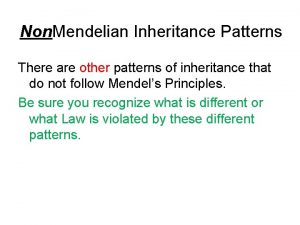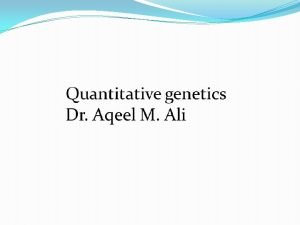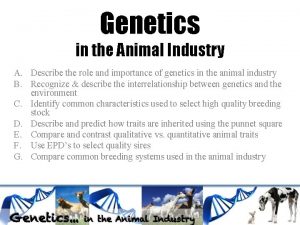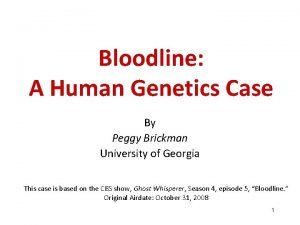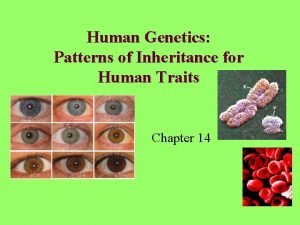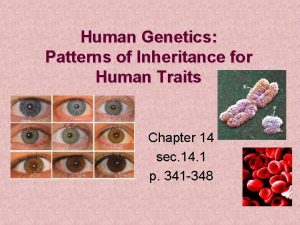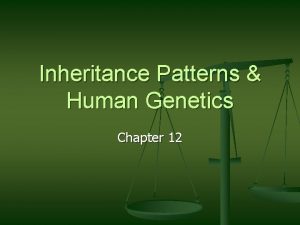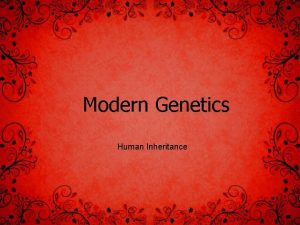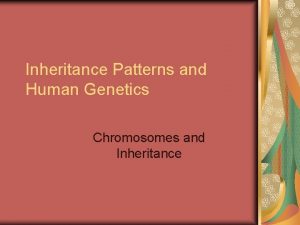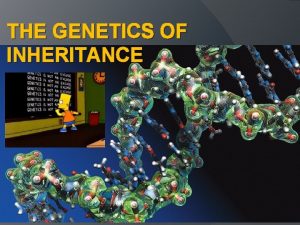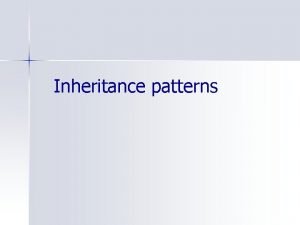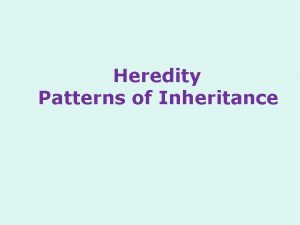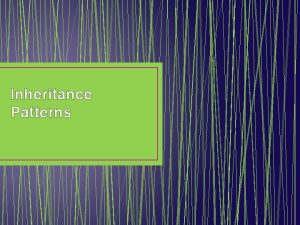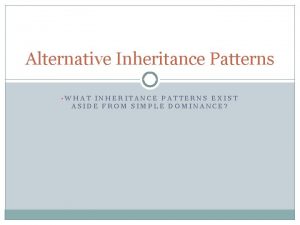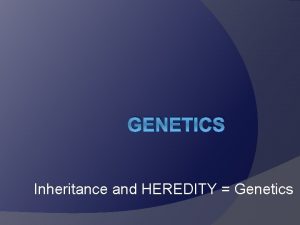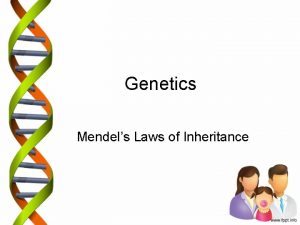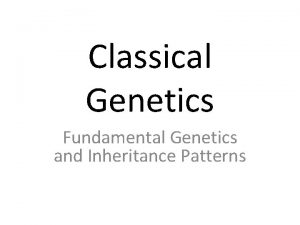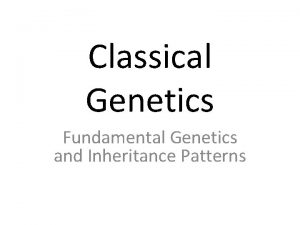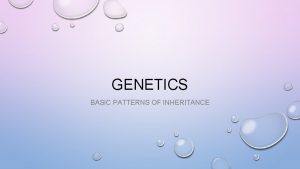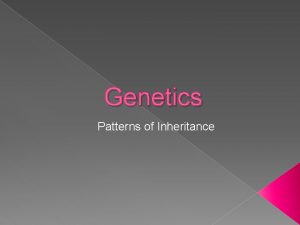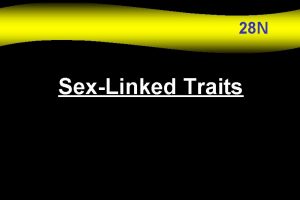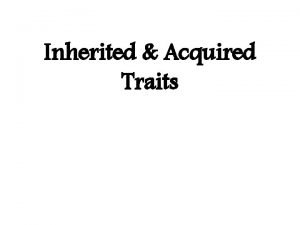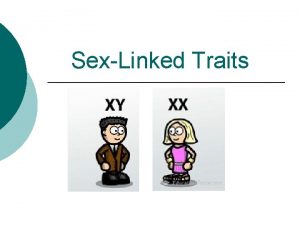Human Genetics Patterns of Inheritance for Human Traits





























































- Slides: 61

Human Genetics: Patterns of Inheritance for Human Traits

Terms to know � Gene – segment of DNA. Carries genetic information that codes for a trait. � Chromosome - compact packages of DNA. Inside nucleus. � Sperm – male sex cell (gamete) � Egg – female sex cell (gamete)

Terms to know � Karyotype A picture. � Autosome – arrangement of chromosomes. - any chromosome that is not a sex chromosome

Terms to know: �Genotype = the genes of an organism; for one specific trait we use two letters to represent the genotype. ◦ A capital letter represents the dominant form of a gene (allele) ◦ A lowercase letter is the abbreviation for the recessive form of the gene (allele). Example: V = dominant v = recessive

Terms to know �Dominant: a gene that is expressed, regardless of whether its counterpart allele on the other chromosome is dominant or recessive. ◦ Ex: VV or Vv = Long wings �Recessive: gene that produces its characteristic phenotype only when its allele is identical; vv= short wings


Terms to know: �Phenotype = the physical appearance of a trait in an organism ◦ BB, Bb = brown eyes ◦ bb = blue eyes

Terms to know �Allele: different versions of the same gene occupying a given position on a chromosome Chromosome from Mom Chromosome from Dad

Terms to know � Organisms that have 2 identical alleles for a particular trait are called homozygous (TT or tt). � Organisms that have 2 different alleles for a particular trait are called heterozygous (Tt).

What makes us human? � The use of a microscope to analyze cells during mitosis shows condensed chromosomes � Scientists cut pictures of these chromosomes out and arrange them into a karyotype (right). =The number and visual appearance of the chromosomes in the cell nuclei of an organism or species in

The beginning � 2 haploid gametes (egg and sperm) join together during fertilization. � The result is a fertilized egg called a zygote which is diploid. � Humans have 46 chromosomes



Male or Female? � Two of the 46 chromosomes are sex chromosomes because they determine whether the zygote will develop into a male or female � Females � Males have XX chromosomes have XY chromosomes

What about the other chromosomes? � The 44 chromosomes that are not sex chromosomes are called autosomes.

Will it be a boy or a girl? � Because of the way sex chromosomes segregate, there is a 50: 50 chance of both males and females being born � All human egg cells carry a single X chromosome, but only half of sperm cells carry an X while the other half carries a Y Which parent determines the sex of the baby?

Human Traits � To identify an inherited trait controlled by a single gene, first we need to determine if that the trait is inherited and not a result of environmental influences. Then, we have to study how it’s passed from one generation to the next

Pedigrees �A pedigree chart shows the relationships within a family and how particular traits are passed from one generation to the next

So can you determine who gave you those good looks? � Nope. Unfortunately, many traits are polygenic, meaning they are controlled by many genes. ◦ Example: eye or ear shape � Additionally many traits are influenced by the environment ◦ Example: genetics determines a person’s maximum possible height, nutrition also plays a role in whether or not that height is ever reached

Important Note: � While it’s important to consider environmental effects on expression of genes… � Environmental effects on genes expression ARE NOT INHERITED!!! ◦ Analogy: Just because someone’s arm gets cut off doesn’t mean their child will be born missing an arm!

YOUR TURN! Determine whether albinism is a dominant or recessive trait: aa Aa Aa Aa aa Recessive

Dominance � Dominant alleles will be expressed even if the recessive allele is present � Codominance: both alleles of a gene pair in a heterozygote are fully expressed, with neither one being dominant or recessive to the other R = Red flower W = White flower RW = Red & White spotted flowers

Incomplete Dominance � Incomplete Dominance: both alleles of a gene are expressed in the phenotype- resulting in combined phenotype red flowers crossed with white flowers = pink flowers

How can you tell the difference? � The trick is to recognize when you are dealing with a question involving incomplete dominance. � There are two steps to this: 1) Notice that the offspring is showing a 3 rd phenotype. The parents each have one, and the offspring are different from the parents. 2) Notice that the trait in the offspring is a blend (mixing) of the parental traits.

Chromosomal Disorders � When meiosis goes wrong and homologous chromosomes fail to separate its called nondisjunction. This means “not coming apart. ” � When this happens abnormal numbers of chromosomes end up in gametes and a disorder of chromosome numbers may result. ◦ Examples: Down Syndrome, Turner’s Syndrome, Klinefelter’s Syndrome

Down Syndrome � If 2 copies of an autosomal chromosome fail to separate in meiosis an individual may be born with 3 copies of a chromosome. This is known as “trisomy” � Down Syndrome is the most common form of this, called Trisomy 21.


Child with Downs Syndrome • The extra chromosome causes problems with the way the body and brain develop.

Sex Chromosome Disorders � In females, nondisjunction can lead to Turner’s Syndrome ◦ She inherits only 1 X (45, X) ◦ Sterile and sex organs don’t develop at puberty � In males, nondisjunction can lead to Klinefelter’s Syndrome (47, XXY) ◦ Extra X interferes with meiosis and usually prevents individuals from reproducing ◦ Estimated 1 in every 500 -600 males ◦ XXXY and XXXXY have been found!

So what happens if a gene sucks? � The Human Genome Project may help in finding cures for genetic disorders through gene therapy. � Gene therapy is the process of changing a gene that causes a genetic disorder. An absent or faulty gene is replaced by a normal, working gene.

Gene Therapy cont…. � The most common form of gene therapy involves using DNA that encodes a functional, therapeutic gene in order to replace a mutated gene. � Today, most gene therapy studies are aimed at cancer and hereditary diseases linked to a genetic defect


Ethically Speaking � If scientists can find ways to cure genetic diseases is it okay if they also start engineering taller people, or their hair color, skin color, sex, blood group or appearance? ? ? � What are the kinds of ramifications (effects) gene therapy in this way could have on human populations in the world?

What about lacking an X? � There have been NO incidences in which an individual lacks an X chromosome all together � This suggests that the X chromosome contains genes that are vital for the survival and development of an embryo

5 Patterns of Inheritance for Human Traits 1. Single Allele Dominant 2. Single Allele Recessive 3. Sex Linked (X-Linked) 4. Multiple Alleles 5. Polygenic Traits

Single Allele Genes � 1. Regular traits that are either determined by a dominant or recessive allele on an autosome Autosomal Dominant examples: a. Huntington’s Disease b. Achondroplasia (dwarfisim) c. Polydactyly (extra fingers and toes) 2. Autosomal Recessive examples: a. Albinism b. Cystic Fibrosis c. Sickle Cell Anemia

1. Dominant Allele Disorders Huntington’s Disease (HD) § Results in loss of muscle control and mental deterioration § No signs are shown until 30’s § Brain degeneration § Treatment: No cure, but drug treatments are available to help manage symptoms.

1. Dominant Allele Disorders Achondroplasia § § Dwarfism Person grows no taller than 4’ 4

1. Dominant Allele Disorders Polydactyly § The presence of more than the normal number of fingers or toes. § Can usually be corrected by surgery.

2. Recessive Allele Disorders Albinism § Lack of pigment in skin, hair, and eyes § Mutation in one of several genes which provide the instructions for producing one of several proteins in charge of making melanin.

2. Recessive Allele Disorders Cystic Fibrosis (CF) § Caused by recessive allele on chromosome 7 § Small genetic change (removes one Amino Acid) changes protein § Results in: Excess mucus in the lungs, liver and digestive tract, gets infection easily, and early death unless treated.

2. Recessive Allele Disorders Sickle Cell Disease § Red blood cells are bent and twisted § Get stuck in capillaries damage tissues § Results in weakness, damage to brain and heart

3. Sex Link Traits: Genes on the X and Y chromosomes

how we determine gender… How do we determine the sex of an individual? through sex chromosomes § Sex Chromosomes: X and Y Female: XX Male: XY § Who is responsible for gender determination in the child? The father because he gives an X or Y to the gametes. The mother only gives an X to the gamete § Which sex chromosome is bigger? the X chromosome (y is much smaller)

What are sex-linked genes? genes found on a sex chromosome � X-linked genes are genes found on the X chromosome, symbolized by Xr, XR, Y 0. � Y-linked genes are found on the Y chromosome, symbolized by X 0, YR, Yr � Thomas Morgan experimented with the eye color of fruit flies (Drosophilia) to determine Xlinkage

Examples of X-linked traits: 1. 2. 3. 4. Color Blindness Muscular Dystrophy Hemophilia Icthyosis simplex (scaly skin)

Sex-Linked Genes � Turns out, there’s a special pattern of inheritance for genes located on the X or Y chromosome. � Because these chromosomes determine sex, genes located on them are termed sex-linked

Colorblindness � About 1 in 10 males is color blind, while 1 in 100 females are color blind in the U. S. � Colorblindness is X-linked. This means that the genes for color vision are located on the X chromosome. � Since females have 2 Xs they have a better shot at color vision, while males only have 1 X which means all X-linked alleles are expressed even if they are recessive.

Colorblindness

Colorblindness �A person with normal color vision sees a number seven in the circle above. � Those at all. who are color blind usually do not see any number

Colorblindness � RED-GREEN COLORBLINDNESS: � People with red-green color blindness see either a three or nothing at all. � Those with normal color vision see an 8.

Duchenne Muscular Dystrophy � Sex-linked � Results in progressive weakening and loss skeletal muscle � 1 in 3, 000 U. S. males is born with it of

What happens to the extra X in females? � Males only get one copy of the X chromosome, so what happens to the extra one in females? � One X is randomly turned “off”. This is called X-Chromosome Inactivation. It forms a dense region in the nucleus called a Barr Body

This happens in cats! � One X chromosome may have the allele for orange spots while the other X may have the allele for black spots � In cells in different parts of the body one X may be turned on while the other X is turned on elsewhere � The cat’s fur will have a mixture of orange and black spots � Fact: If a cat has 3 colors, it’s female. Males can only have 2 colors (unless they have genetic disorder)!

Hemophilia- Lacking in the ability to clot blood ◦ There is a gene on the “X” chromosome that controls blood clotting ◦ People who have hemophilia are missing the protein to clot blood ◦ They can bleed to death by a minor cut.

Muscular Dystrophy - Results in weakening/loss of muscles - Caused by defective version of gene that codes for muscle

Sex-influenced Traits � Sex-Influenced traits are those that are on autosomes, but occur because of the sex hormones in male and female bodies. � Examples: Facial hair Baldness

4. Multiple Alleles – any gene that has 3 or more alleles (not just 1 dominant and 1 recessive) Example: Blood type has 3 alleles: IA= Type A blood (dominant) IB= Type B blood (dominant) i = Type O blood (recessive)

Check out the possible genotypes and phenotypes of blood below: Genotypes Phenotypes IAIA or IAi Type A IBIB or IBi Type B I AI B Type AB ii Type O

Blood has both Multiple Alleles and is Co. Dominant � If you have IAIB as your genes, you have both Type A and Type B blood, also known as Type AB � If you have IAi, i is recessive IA, so you have type A blood � Q. When would you have Type O blood? � A. When you have ii as your genotype. to

5. Polygenic Traits – traits controlled by 2 or more genes that interact, forming the trait § § Usually show a wide range of phenotypes Ex: Skin color, eye color, foot size, height �Wide range of skin colors because there are more than 4 genes that control this trait. § These may also be influenced by the environment, for example height. If not given the proper nutrition as a child, they might not be as tall as their genes dictate.
 Human inheritance modern genetics answer key
Human inheritance modern genetics answer key Genetics graphic organizer
Genetics graphic organizer Modern genetics human inheritance answer key
Modern genetics human inheritance answer key Chapter 11 section 1 basic patterns of human inheritance
Chapter 11 section 1 basic patterns of human inheritance Chapter 11 section 1 basic patterns of human inheritance
Chapter 11 section 1 basic patterns of human inheritance Inheritance of quantitative traits
Inheritance of quantitative traits Inheritance of quantitative traits
Inheritance of quantitative traits Inheritance of quantitative traits
Inheritance of quantitative traits Complete dominance pattern of inheritance
Complete dominance pattern of inheritance Complex patterns of inheritance
Complex patterns of inheritance Complex patterns of inheritance
Complex patterns of inheritance A gene locus is
A gene locus is Mendelian inheritance patterns
Mendelian inheritance patterns Chapter 9 patterns of inheritance
Chapter 9 patterns of inheritance Qualitative traits vs quantitative traits
Qualitative traits vs quantitative traits Qualitative traits vs quantitative traits
Qualitative traits vs quantitative traits Chapter 11 complex inheritance and human heredity test
Chapter 11 complex inheritance and human heredity test Individual culture traits combine to form culture patterns.
Individual culture traits combine to form culture patterns. Section 14-3 human molecular genetics answers
Section 14-3 human molecular genetics answers Introduction to genetic analysis tenth edition
Introduction to genetic analysis tenth edition Peggy brickman
Peggy brickman In traditional dating patterns dating behavior
In traditional dating patterns dating behavior X videos
X videos Formuö
Formuö Typiska novell drag
Typiska novell drag Tack för att ni lyssnade bild
Tack för att ni lyssnade bild Vad står k.r.å.k.a.n för
Vad står k.r.å.k.a.n för Varför kallas perioden 1918-1939 för mellankrigstiden
Varför kallas perioden 1918-1939 för mellankrigstiden En lathund för arbete med kontinuitetshantering
En lathund för arbete med kontinuitetshantering Kassaregister ideell förening
Kassaregister ideell förening Personlig tidbok fylla i
Personlig tidbok fylla i A gastrica
A gastrica Densitet vatten
Densitet vatten Datorkunskap för nybörjare
Datorkunskap för nybörjare Tack för att ni lyssnade bild
Tack för att ni lyssnade bild Debatt artikel mall
Debatt artikel mall Delegerande ledarskap
Delegerande ledarskap Nyckelkompetenser för livslångt lärande
Nyckelkompetenser för livslångt lärande Påbyggnader för flakfordon
Påbyggnader för flakfordon Formel för lufttryck
Formel för lufttryck Publik sektor
Publik sektor I gullregnens månad
I gullregnens månad Presentera för publik crossboss
Presentera för publik crossboss Vad är ett minoritetsspråk
Vad är ett minoritetsspråk Bat mitza
Bat mitza Klassificeringsstruktur för kommunala verksamheter
Klassificeringsstruktur för kommunala verksamheter Fimbrietratt
Fimbrietratt Claes martinsson
Claes martinsson Centrum för kunskap och säkerhet
Centrum för kunskap och säkerhet Programskede byggprocessen
Programskede byggprocessen Mat för idrottare
Mat för idrottare Verktyg för automatisering av utbetalningar
Verktyg för automatisering av utbetalningar Rutin för avvikelsehantering
Rutin för avvikelsehantering Smärtskolan kunskap för livet
Smärtskolan kunskap för livet Ministerstyre för och nackdelar
Ministerstyre för och nackdelar Tack för att ni har lyssnat
Tack för att ni har lyssnat Hur ser ett referat ut
Hur ser ett referat ut Redogör för vad psykologi är
Redogör för vad psykologi är Stål för stötfångarsystem
Stål för stötfångarsystem Tack för att ni har lyssnat
Tack för att ni har lyssnat Borra hål för knoppar
Borra hål för knoppar Vilken grundregel finns det för tronföljden i sverige?
Vilken grundregel finns det för tronföljden i sverige?
